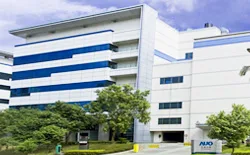It is the height of summer and exciting news is getting sparse for the most part, if we just forget the US political race to the White House in 2016 for a moment. While the upcoming US elections provide some interesting sound bites, the visual appeal is somewhat limited.

In a very short note, AUO announced this week that it sold its Gen 3.5 LCD fab to Wistron NeWeb (AUO sells old LCD Fab to Wistron NeWeb). The article claims that Wistron NeWeb, an ODM/JDM/OEM manufacturer for wireless communication products, is buying the AUO LC3A in Hsinchu, Taiwan for a sum of NT$810 million ($25.6 million). According to Digitimes, there is very little info on the deal other than the fab is only sparsely used by AUO for production and the line is basically outdated.
Neither the AUO nor the Wistron NeWeb site actually provide any confirmation or details on the deal.
Source: AUO – FAB L3A
AUO still has three other Gen 3.5 fabs, where L3B is already converted for experimental production and LC3 and L3D are still used for production. L3A was first installed at the end of 1999 and is almost 15 years old. A good age for a high tech technology site at first glance. The article also says that AUO is receiving a capital gain of NT$550 million ($17.4 million) from this transaction. This shows that the fab was more or less written off completely.
While 2015 has not been kind to the AUO stock value, we can exclude that financial gains were a major factor in selling the fab to Wistron NeWeb. The AUO investment plan for this and next year calls for investments in the order of NT$40 ($1.26 billion), far above the received $25 million check. We have to acknowledge that the key issue for AUO is the low capacity load for products from this fab.
This does raise the question of what Wistron NeWeb is planning to do with this fab? The company has “fundamental strengths in antennas and RF for a wide range of applications including home, mobile, automotive, and enterprise applications”. If we forget the option of using the clean room space in the factory for other manufacturing purposes and throwing the LCD equipment out for a moment, we may assume that it is planning to make its own LCDs in the fab. So it must be a great fit for someone making antennas to start making LCDs on an outdated fabrication line.
There is no question in my mind that Wistron NeWeb is using a lot of LCDs of varying sizes in its devices, and those displays may have come from AUO so far. In a former life, Wistron was the manufacturing arm of Acer and AUO has developed from Acer Display by incorporating other LCD makers. The question is why AUO is not just moving the production to its other Gen 3.5 fabs that are still in operation? Instead the company is selling its manufacturing facility to its customer.
The most logical interpretation is that AUO does not want to make such LCDs anymore, instead it is focusing on moving the company into higher resolution LCD and OLED panels. If AUO can’t make money on the old panels a sale of the assets allows the company to focus completely on future products. Of course the question is, what will AUO be doing with the other Gen 3.5 lines? And furthermore, what will this do to the overall LCD market?
In total dollars, I doubt if the sales from this fab made up more than a tenth of a percent of the global LCD market, but if manufacturers are now making their own LCD panels for their devices where does this lead to? In recent decades, the wisdom was that combining manufacturing of high tech products such as LCDs in a large factory makes a lot of sense. As a consequence North America and Western Europe have basically abandoned all display manufacturing for commodity products. Focus was here on high-end devices for military and commercial markets. Success stories in commodity displays are hard to come by these days. The greatest success stories in the US are E-Ink and Kent that are actually manufacturing display panels in the USA.
Does this new development mean that the display powerhouses of the world are giving up on the low-end LCD products and leaving it to their customers to make themselves? This is a very interesting development with a lot of potential changes for the display and other industries in coming years. – Norbert Hildebrand

